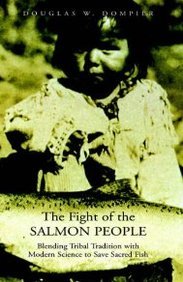Items related to The Fight of the Salmon People

"The Fight of the Salmon People" is written by Douglas W. Dompier. For thousands of years, Indian people lived in the Columbia River basin where salmon became the foundation of their culture, religion, and economy. Lewis and Clark were amazed at the abundance of salmon upon their arrival in 1805. However, that abundance began to diminish as more and more settlers arrived and they began to change the region's landscape. Settlers to the region found the ground fertile for a multitude of crops and soon their irrigation programs east of the Cascade Mountains diverted water to the parched land that allowed the new industry to flourish. Trees of the forest seemed endless, and soon the timber industry became a dominant force in the region. Many of the streams were turned inside out as gold miners sought to extract the precious metal from the salmon's spawning gravel. Meanwhile, with the development of the canning industry, salmon offered a bounty to the non-Indian commercial fishers. Their ingenuity to devise modern harvest equipment and techniques allowed them to catch more and more of the valuable resource.As the region emerged from the Great Depression, the environmental insult that rendered the salmon's utilization of its habitat an almost fatal blow was the construction of the hydroelectric dams. A once-majestic and free-flowing river system was blocked or turned into a series of lakes and reservoirs. For many residents, the solution was the construction of fish hatcheries to offset the continual loss of the resource. Numerous papers, reports, and books were written about the damage inflicted on the salmon resources of the Columbia River due to the development of the basin, particularly the injury due to hydroelectric dams. Although loss of Columbia River salmon is often attributed to those dams, serious decline of salmon began nearly a century earlier. Initial loss of salmon was due to commercial fishing and damage to tributary spawning and rearing habitat. Construction of dams began in earnest during the Great Depression of the 1930s. Within the span of less than forty years, the Columbia River and its major tributaries would be rocked with the construction of more than thirty major dams.Passage of the Fish and Wildlife Coordination Act and Mitchell Act, at the time main-stem dam construction began, provided fishery agencies with crucial federal legislation to aid salmon runs the dams injured. Enactment of the acts offered opportunities for fish passage at the dams, habitat improvement projects, and construction of hatcheries in Washington, Oregon, and Idaho. However, habitat-improvement projects and hatchery construction in the Columbia River basin remained insignificant until the Mitchell Act and Fish and Wildlife Coordination Act were both amended in 1946. The amended acts became the principle vehicles that allowed fishery agencies to secure federal funds, primarily from the Corps of Engineers, through the construction of the dams they built on the main stems of the Columbia River and Snake River and some of the major tributaries of those rivers. This association led to the creation of one of the world's largest complex of salmon hatcheries on the Columbia River and its major tributaries.For the next forty years, state and federal fishery agencies utilized the allocations to build hatcheries that provided them the means to gain control of salmon runs of the Columbia River. In the 1980s, the four tribes with reserved treaty fishing rights within the Columbia River basin began to challenge that domination and called for alteration of the operation of salmon hatcheries to assist naturally spawning runs. As the tribes' efforts to reform salmon hatcheries to supplement naturally spawning salmon runs gained momentum, fishery agencies started to question the appropriateness of hatchery-reared fish to restore naturally spawning populations. Hatchery-reared salmon were viewed as inferior and interactions with wild fish were not encouraged.
"synopsis" may belong to another edition of this title.
- PublisherXlibris Corporation
- Publication date2005
- ISBN 10 1413492967
- ISBN 13 9781413492965
- BindingPaperback
- Number of pages351
(No Available Copies)
Search Books: Create a WantIf you know the book but cannot find it on AbeBooks, we can automatically search for it on your behalf as new inventory is added. If it is added to AbeBooks by one of our member booksellers, we will notify you!
Create a Want
